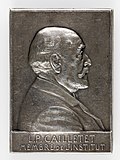Louis Paul Cailletet
Louis Paul Cailletet (born September 21, 1832 in Châtillon-sur-Seine , † January 5, 1913 in Paris ) was a French physicist .
Life
Cailletet studied at the Lycée Henri IV and at the École des mines . He then took over the management of his father's iron works. There he examined metallurgical processes in detail and published a whole series of treatises.
His findings on the liquefaction of so-called permanent gases (such as oxygen and nitrogen ) were groundbreaking . Cailletet liquefied these substances, which up until then had only existed in gaseous form , under high pressure and great cooling in his laboratory on December 2, 1877. With his method he could only get small droplets of liquid gas . The physicist Raoul Pictet in Geneva came to the same conclusion 20 days after him . However, he used a different method, which Heike Kamerlingh Onnes later refined and which led to the discovery of the superfluidity of the noble gas helium . The liquefaction of the permanent gases was the most important technical requirement for the discovery of superconductivity .

|

|
|
|
Medal (from Frédéric de Vernon ) for Cailletets silver Academy anniversary in 1909, with representations of his physical experiments
|
||
In 1894 Cailletet was able to show by automatic sampling with a vessel on an unmanned balloon that the composition of the atmosphere is constant up to an altitude of 15 km. In doing so, he confirmed the results of Joseph Louis Gay-Lussac , who had already come to the same result during his balloon flight at an altitude of 7 km in 1804.
In 1884 the Académie des Sciences appointed Cailletet to its membership.
On March 18, 2003, an asteroid was named after him: (13219) Cailletet .
Web links
- Article by / about Louis Cailletet in the Polytechnic Journal
| personal data | |
|---|---|
| SURNAME | Cailletet, Louis Paul |
| BRIEF DESCRIPTION | French physicist |
| DATE OF BIRTH | September 21, 1832 |
| PLACE OF BIRTH | Châtillon-sur-Seine |
| DATE OF DEATH | January 5, 1913 |
| Place of death | Paris |
